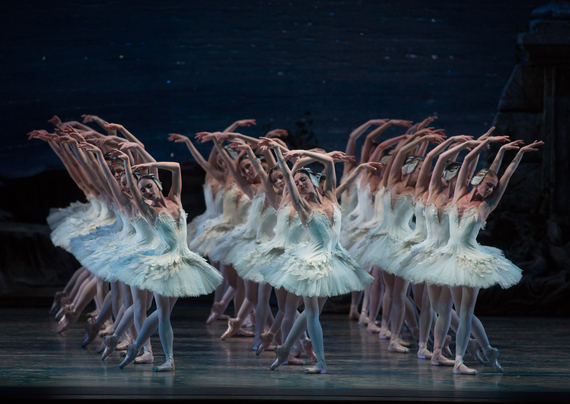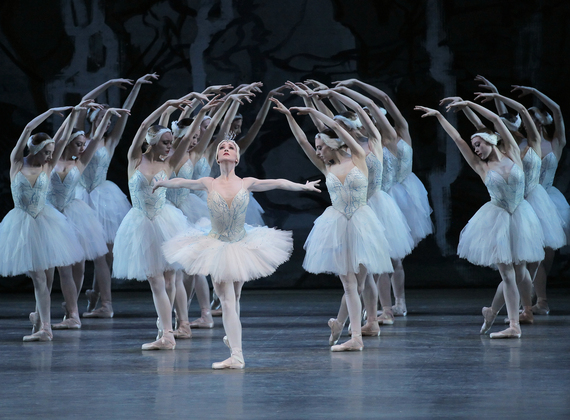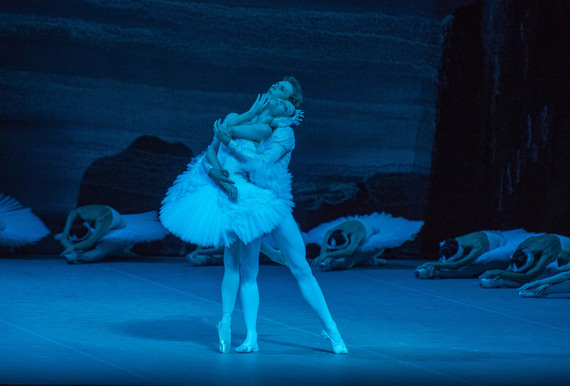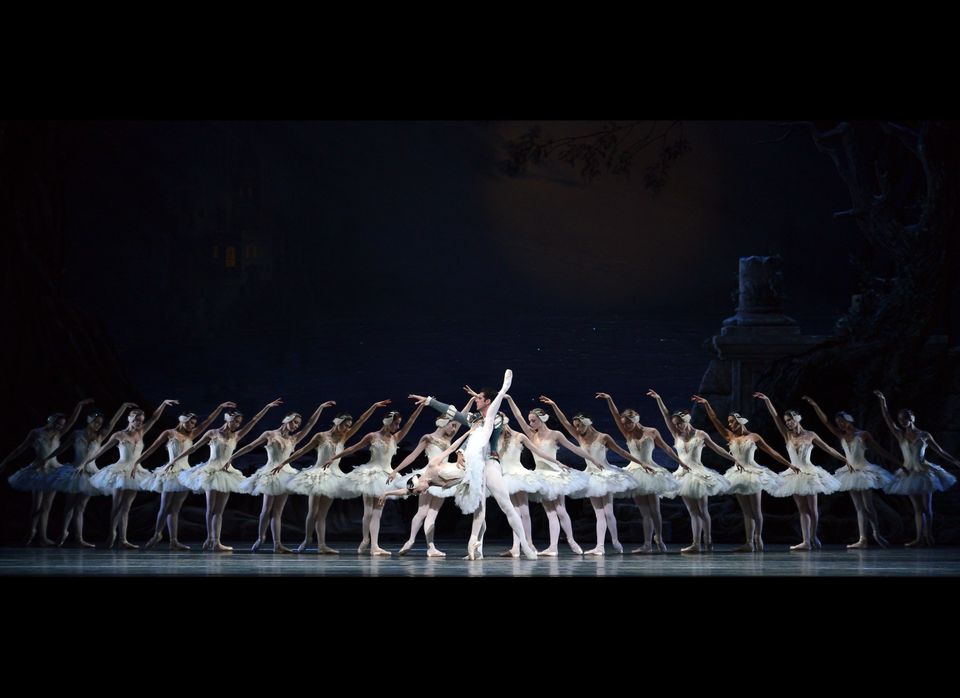The Bolshoi Ballet is in town. Its season opener, Swan Lake, sold out almost instantly, leaving less aggressive ticket buyers sorely disappointed. The appeal of a night with the Bolshoi is not just a chance to see the company's dramatic Russian style, but also to compare repertory that overlaps with our native New York companies. Whether you want to see it with the Bolshoi or not, it has been close to impossible to secure a ticket recently to see any production of Swan Lake in New York City, and the dance community perhaps has Darren Aronofsky to thank for it. His 2010 film "Black Swan" not only garnered Natalie Portman a Best Actress Oscar win, but also prompted a new interest in the ballet that inspired it. Swan Lake has been further cemented into the public consciousness as one of the main work associated with the artform of classical ballet.
There have been no shortages of Swan Lakes this season in New York. Les Ballet de Monte Carlo presented a contemporary version by Jean-Christophe Maillot at City Center, the Royal Ballet's cinema broadcast introduced us to Anthony Dowell's staging, and last year we saw the Mariinsky Ballet "in 3D!" For a live performance, New Yorkers have two main outlets to see a classical production: Kevin McKenzie's version from 2000 for American Ballet Theatre (available on film starring Gillian Murphy and Angel Corella) or Peter Martin's 1999 version for the New York City Ballet (seen on "Live from Lincoln Center" with Miranda Weese and Damian Woetzel). And during Lincoln Center Festival's presentation of the Bolshoi Ballet performing Yuri Grigorovich's revised 2001 production this summer, New Yorkers now have seen a third.
The common ancestor of all three of these productions stems from the second revival of Tchaikovsky's ballet with new choreography by Marius Petipa, ballet master of the St. Petersburg Imperial Theatre (now St. Petersburg's Mariinsky Ballet). He is responsible for the choreographic style of classical ballet, and even bringing older romantic works "up to date," restaging romantic works like "Giselle" to include more dancing.
The ballet master had his sights on the failed 1877 Bolshoi production, with lackluster choreography by the Czech balletmaster Julius Reisinger. The redeeming quality of the ballet was the score by Peter Tchaikovsky. Petipa was well suited to tackle the first and third act: the Germanic court scenes, including the notoriously difficult Black Swan Pas de deux, gave the French-born Petipa a chance to bring his Western European influence to the still adolescent Imperial Theatre.
It was Petipa's assistant, Russian balletmaster Lev Ivanov, who was charged with creating the dances for the swans. A native Russian, Ivanov created beautiful dances for the swan maidens inspired by Slavic ring dance patterns and by traditional Russian folk dances. The resulting tension between Petipa's Western court steps to Russian Ivanov's wild folk dances, pitting nature again culture, black against white, and Good versus Evil is what makes Swan Lake a ballet that continues to have great artistic appeal for contemporary audiences.
With steps passed down from generation to generation like a choreographic game of telephone, the dances inevitably change both to suit the times and the companies that produce them. It is from this perspective that we can more fully appreciate the differences between each production, and also how each company's interpretation of Swan Lake is deeply reflective of their respective artistic styles and philosophies.
ABT has long prided itself in being a "melting pot, not only of international cultural experiences, but of international training." It is not surprising then, as America's National Ballet Company, ABT has the unspoken responsibility to maintain a production of the highest international standards, rivaling those from European and Russian companies with a longer tradition or company style. Introduced in the early 1800s, ballet in America is still a young artform, compared ballet in Russia, which is the object of extreme fanaticism, introduced in the 1700s by Peter the Great's "Westernization." In Russia, ballet is comparable to American's penchant for sports. (Can you imagine tailgating outside of the Metropolitan Opera before "The Sleeping Beauty?" Maybe in another hundred years...?)
ABT's current production of Swan Lake by Artistic Director Kevin McKenzie in collaboration with Susan Jones fits that bill. It is heavily influenced by the dance notations from the Sergeyev Collection, a series of choreographic notations that Nicholas Sergeyev, a ballet master with Imperial Mariinsky Theatre, took out of Russia during the Russian Revolution in 1917. He brought his notes to England, where they first helped lay the groundwork for native British ballet.
With the strong British influence throughout ABT's history -- it currently counts its Macmillan and Ashton repertory among its greatest strengths -- it is no surprise that ABT has focused on the narrative potential of the work. Ballet in Britain has been strongly influenced by pantomime; early ballet in Britain was often found wedged between popular "panto" routines. This production is a product of this influence: the overture music accompanies a scene of a girl being abducted by the sorcerer Von Rothbart and transformed into a swan. Though not original to this production, this additional tableau provides a 21st-century audience a visual backstory for the scenario of the ballet. This earlier scene for the ballerina diminishes the drama of the more traditional and musically-correct second act entrance, and changes the narrative arc. Is this story about a confused prince or the tragedy of the Swan Queen? The answer is both; the apotheosis of the ballet ends with the lovers reunited in the afterworld. This ending is the most true to the Petipa/Ivanov revival compared to the Martins or Grigorovich productions.
A different Russian influence dominates across the plaza. George Balanchine's New York City Ballet has been the home of his neoclassical style, drawing from his own legacy as a Mariinsky dancer. The company's current production features choreography by Ballet Master in Chief Peter Martins. He cites as influences not only Petipa and Ivanov but also George Balanchine, whose one-act "Swan Lake" suite is also sometimes performed. Danish-born Martins began performing as a guest artist with New York City Ballet in 1967 while already an established star with the Royal Danish Ballet, joining Balanchine's New York-based company as a Principal Dancer in 1970. Retiring from dance in 1983, he assumed the role of Ballet Master in Chief, and has been charged with continuing Balanchine's legacy ahead into the future. His "Swan Lake" premiered on October 27, 1996 with the Royal Danish Ballet and on April 29, 1999 with the New York City Ballet.
Martins approaches "Swan Lake" like an impressionist painting. It is more abstract than real, more allegory than fairy tale. We are seeing Petipa through the lens of Balanchine as imagined by Martins. As a full-length narrative, it follows Balanchine's stylized storytelling in the vein of his 1949 production Firebird (revived in 1970 with the now iconic sets and costumes by Marc Chagall). Where ABT strives for realism, Martins, in collaboration with Danish painter Per Kirkeby, strives to create an extreme environment throbbing with color and contrast, light and shadow. The steps themselves take on a lighter, faster quality throughout, and are constrained by a much quicker tempo, leaving its swans to navigate certain sections of Tchaikovsky's score as though flying through gale force winds.
Ashley Bouder, one of New York City Ballet Principal Dancers who performs the role of the Swan Queen said, "I'm the shortest dancer who performs the role at New York City Ballet. I can't dance the White Swan Pas de Deux to the same tempo that Svetlana Zakharova [of the Bolshoi Ballet] does. Because of our proportions, the tempo that works for her would look painfully slow on me, and the audience wouldn't respond well." She has a point - and the Martins production is kept briskly moving along. The corps de ballet is also more than passive scenery, Martins gives his swan maidens plenty of dancing - continuing one of Balanchine's neoclassical innovations of making the corps de ballet more than human mise-en-scène.
THE BOLSHOI BALLET
Where the City Ballet dancers are a flock, the Bolshoi swans are a prism, creating the illusion of a seemingly endless reflection of the tragedy of Odette. Making their entrance, each swan becomes a ripple on the lake, a glitter of white catching the moonlight. Then organized like feathers, the swan women breathe as an extension of Odette's wings.
The Russian dancers have a stylistic advantage to their American counterparts: character dancing (a subset of classical dancing, it is a stylized manifestation of mostly European folk dances) is a focused part of the ballet curriculum in Russia. The swans are not "ballerinas," but rather Russian maidens transformed into swans, their ring patterns and even their steps themselves derived from folk dances. With this training, the Bolshoi dancers capture the wildness of the swans while maintaining an expressive upper body, a hallmark incubated behind the Iron Curtain by Russian companies. These Bolshoi swans have urgency.
This current production is by Yuri Grigorovich, the Artistic Director of the company from 1964 until 1995, and is a Soviet choreographic schizophrenia including not only steps from Petipa and Ivanov but also retaining modifications by Alexander Gorsky, another ballet master with the Bolshoi Theatre, who became well known for restaging Petipa ballets. Grigorovich has expanded the role of von Rothbart, making him the dark foil to Prince Siegfred, as the black swan Odile is to the white Odette. This perhaps adds to the psychological tension of the work, but muddles the interpretation of the score. Grigorovich butchers the entrance of the swans, as they appear abruptly and unmusically out of nowhere.
The narrative also takes a backseat to an overall sense of technical theatrics, nowhere more evident than in the climax of the ballet, the Black Swan's infamous 32 fouette turns. Petipa's choreographic artistry elevated the fouette turns from an Italian parlor trick to a demonstration of the power Odile has over the confused Prince. Having been whipped into a lusty frenzy, he responds with his own set of bravura turns, discarding all courtly self-control.
In the Grigorovich production, the ballerina finishes the turns, then pauses for applause. The prince then returns to ballroom (he was waiting offstage in the wings) to do his series of turns. The convention of taking a bow in the middle of the coda (finale) of pas de deux is something Western ballet companies tend to avoid. For Grigorovich, the fouettes once again become just a trick - but they are still dazzling. While it is not a part of the choreography, the mid-show bows are definitely a part of the performance, and American audiences are given the chance to revel in a little Russian embellishment.
The reason why the Bolshoi can get away with this is that it is paired with the Bolshoi Orchestra, conducted by Pavel Sorokin. Peering into the orchestra pit at the David H. Koch Theater, one could see that a row of seats has been removed to accommodate the extra double basses, cellos, and expanded percussion section. The extra instruments make a difference; there is a sensitivity to the Russian score and a symphonic fullness that exposes the intended musical tension and highlights the choreographic drama. Despite being an imperfect narrative vehicle, the Grigorovich production highlights the bold Bolshoi aesthetic.
With three different contemporary incarnations of the same work, we can see what parts of the original production are maintained as sacred, what elements are tossed out and reconceived. With each of these three world-class productions taking such varied approaches to both the classical music and the choreography, an audience member's individual choice of a favorite production ultimately lies in what they want to come away with at the end of a night at the ballet. This diversity demonstrates that ballet is open to change, innovation, adaptation, and interpretation, while still retaining the deep original meanings, feelings, impact, and spirit of the original works. This is both the paradox of classicism in ballet and the key to its artistically sustainability.
Special thanks to Marian Smith of the University of Oregon and Doug Fullington of Pacific Northwest Ballet for their invaluable historical insight.





